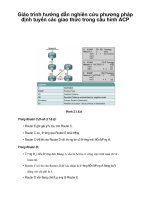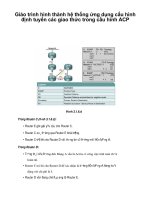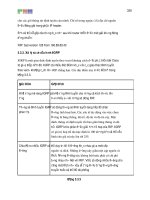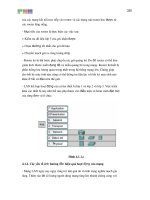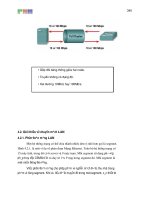acp-wgi08-wp08_doc9896_142_draftb_mb
Bạn đang xem bản rút gọn của tài liệu. Xem và tải ngay bản đầy đủ của tài liệu tại đây (1.47 MB, 73 trang )
ICAO
Aeronautical Telecommunication Network (ATN)
Manual for the ATN using IPS Standards and
Protocols (Doc 9896)
Prepared by: ICAO ACP WG-I
August 25, 2008
Version 14ba
DRAFT ICAO Manual for the ATN using IPS Standards and Protocols (Doc 9896)
Version 14 ba August 25, 2008
FOREWORD
This document defines the requisite data communications protocols and services to be
used for implementing the International Civil Aviation Organization (ICAO) Aeronautical
Telecommunications Network (ATN) using the Internet Protocol Suite (IPS). The
material in this document is to be considered in conjunction with the relevant Standards
and Recommended Practices (SARPs) as contained in Annex 10, Volume III, Part I
Chapter 3.
Editorial practices in this document.
The detailed technical specifications in this document that include the operative verb
“shall” are essential to be implemented to secure proper operation of the ATN.
The detailed technical specifications in this document that include the operative verb
“should” are recommended for implementation in the ATN. However, particular
implementations may not require this specification to be implemented.
The detailed technical specifications in this document that include the operative verb
“may” are optional. The use or non use of optional items shall not prevent interoperability
between ATN/IPS nodes.
The Manual for the ATN using IPS Standards and Protocols is divided into the following
parts:
Part I – Detailed Technical Specifications
This section contains general description of Internet Protocol Suite (IPS) communications
including information on user requirements. Information on institutional guidelines to
IPS services and the Standards and Recommended Practices (SARPS).
Part II – IPS Applications
This section contains general description of IPS applications, possible implementations of
IPS DS and examples of IPS applications being supported by ICAO Annex 10 material.
Part III – Guidance Material
This section contains guidance material on IPS communications including information on
potential operational benefits, architectures, IPS addressing plan, AS numbering plan and
general information on IPS implementation.
i
ICAO
Aeronautical Telecommunication Network (ATN)
Manual for the ATN using IPS Standards and
Protocols (Doc 9896)
Part I
Detailed Technical Specifications
DRAFT ICAO Manual for the ATN using IPS Standards and Protocols (Doc 9896)
Version 14 ba August 25, 2008
PART 1 TABLE OF CONTENTS
1.0 INTRODUCTION..........................................................................................................1
1.1 GENERAL OVERVIEW
1
2.0 REQUIREMENTS.........................................................................................................3
2.1 ATN/IPS ADMINISTRATION
3
2.1.1 The ATN/IPS.....................................................................................................3
2.1.2 Administrative Domains...................................................................................3
2.2 PHYSICAL LAYER & LINK LAYER REQUIREMENTS
4
2.3 NETWORK LAYER REQUIREMENTS
4
2.3.1 General IPv6 InternNetworking and Mobility.................................................4
2.3.2 MOBILITY
5
2.3.2 3 Network Addressing.......................................................................................5
2.3.3 Inter-Domain Routing......................................................................................6
2.3.4 Error Detection and Reporting........................................................................7
2.3.5 Quality of Service (QoS)...................................................................................7
2.3.6 IPv4 to IPv6 Transition....................................................................................8
2.4 TRANSPORT LAYER REQUIREMENTS
8
2.4.1 End- to- End Services.......................................................................................8
2.4.2 Support Services...............................................................................................8
2.4.3 Transmission Control Protocol (TCP).............................................................8
2.4.4 User Datagram Protocol (UDP)......................................................................8
2.5 SECURITY
8
2.5.2 Ground-Ground Security..................................................................................9
2.5.3 Air-Ground Security.......................................................................................10
1.0 INTRODUCTION..........................................................................................................3
1.2 Objective..............................................................................................................3
2.0 LEGACY ATN APPLICATIONS................................................................................3
..................................................................................................................................................3
2.1 LEGACY ATN/OSI APPLICATIONS, USING IPS
3
2.1.1 Support for CPDLC..........................................................................................4
2.1.2 Support for CM.................................................................................................4
2.1.3 Air-Ground Applications over ATN IPS...........................................................4
2.1.4 Parameters of the ATNPKT..............................................................................5
2.2 GROUND-GROUND APPLICATIONS
5
2.2.1 ATSMHS...........................................................................................................5
2.2.2 AIDC.................................................................................................................6
2.2.3 Voice over Internet Protocol (VoIP).................................................................6
3.0 APPLICATION SERVICES.........................................................................................4
i
DRAFT ICAO Manual for the ATN using IPS Standards and Protocols (Doc 9896)
Version 14 ba August 25, 2008
3.1 IPS DS
4
3.1.1 Services and Primitives....................................................................................5
3.1.2 Protocol............................................................................................................6
3.1.3 Packet Format..................................................................................................7
3.1.4 ATNPKT Version...............................................................................................8
3.1.5 DS Primitive.....................................................................................................8
3.1.6 Content Type.....................................................................................................8
3.1.7 Content Version................................................................................................9
3.1.8 Called Peer ID..................................................................................................9
3.1.9 Calling Peer ID................................................................................................9
3.1.10 Security Requirements....................................................................................9
3.1.11 Reject Source..................................................................................................9
3.1.12 Result..............................................................................................................9
3.1.13 Application Technology Type..........................................................................9
3.1.14 User Data Length.........................................................................................10
3.1.15 User Data.....................................................................................................10
3.1.16 Multiple Application Instantiations..............................................................10
3.2 OLDI
11
3.3 FMTP
11
3.3.1 Testing OLDI/FMTP.......................................................................................12
1.1 BACKGROUND
5
APPENDIX A – REFERENCE DOCUMENTS.............................................................20
APPENDIX B – ABBREVIATIONS/DEFINITIONS.....................................................1
APPENDIX C – AS NUMBERING PLAN.......................................................................4
TABLE OF FIGURES
FIGURE 1 – IPS ARCHITECTURE IN THE ATN.........................................................1
ii
DRAFT ICAO Manual for the ATN using IPS Standards and Protocols (Doc 9896)
Version 14 ba August 25, 2008
1.0 INTRODUCTION
1.1 GENERAL OVERVIEW
This manual contains the minimum communication protocols and services that will
enable implementation of an ICAO Aeronautical Telecommunication Network (ATN)
based on the Internet Protocol Suite (IPS) utilizing Internet Protocol version 6 (IPv6).
Implementation of IPv4 in ground networks, for transition to IPv6 ground networks (or as
a permanent network) is a local issue, and is not addressed in this manual. IPv6 is to be
implemented in air-ground networks. The scope of this manual is on interoperability
across administrative domains in the ATN/IPS internetwork, although the material in this
manual can also be used within an Administrative Domain.
The IPS in the ATN architecture is illustrated in Figure 1.
Figure 1 – IPS Architecture in the ATN
1
DRAFT ICAO Manual for the ATN using IPS Standards and Protocols (Doc 9896)
Version 14 ba August 25, 2008
In accordance with Annex 10, Volume III, Part I, paragraph [3.3.3] implementation of the
ATN/IPS, including the protocols and services included in this manual, will take place on
the basis of regional air navigation agreements between ICAO contracting States.
Regional planning and implementation groups (PIRG’s) are coordinating such
agreements.
2
DRAFT ICAO Manual for the ATN using IPS Standards and Protocols (Doc 9896)
Version 14 ba August 25, 2008
2.0 REQUIREMENTS
2.1 ATN/IPS ADMINISTRATION
2.1.1 The ATN/IPS
Note 1. — 2.1.1.1
The ATN/IPS internetwork consists of Internet Protocol Suite
(IPS) nodes and networks operating in a multinational environment. The ATN/IPS
internetwork is capable of supporting Air Traffic Service Communication (ATSC) as
well as Aeronautical Industry Service Communication (AINSC), such as Aeronautical
Administrative Communications (AAC), Aeronautical Passenger Communication
(APC) and Aeronautical Operational Communications (AOC).
Note 2. — 2.1.1.2 In this manual an IPS node is a device that implements IPv6. There
are two types of IPS nodes in the ATN.
• An IPS Router is an IPS node that forwards Internet Protocol (IP) packets not
explicitly addressed to itself.
• An IPS host is an IPS node that is not a router.
2.1.2 Administrative Domains
Note. — 2.1.2.1
From an administrative perspective, the ATN/IPS internetwork
consists of a number of interconnected Administrative Domains (AD). An
Administrative Domain can be an individual State, a group of States (e.g., an ICAO
Region), an Air Communications Service Provider (ACSP), an Air Navigation Service
Provider (ANSP), or other organizational entity that manages ATN/IPS network
resources and services.
2.1.2.21
Each Administrative Domain participating in the ATN/IPS internetwork
MB: Not too
shall operate one or more IPSInter-domain R routers which execute the inter-domain
certain about this
routing protocol specified in this manual.
definition.
2.1.2.3Note. — From a routing perspective, inter-domain routing protocols are used to
exchange routing information between Autonomous Systems (AS), where an AS is a
connected group of one or more IP prefixes. The routing information exchanged includes
these
paragraphs
IP address prefixes of differing lengths depending on the type of AD.DoFor
example,
an IPbelong at
the length
same level
address prefix exchanged between ICAO regions may have a shorter
than as
anthe
IP
preceeding
paragraphs?
address prefix exchanged between individual states within a particular region.
MB: Not too
Maybe there should be a
certain
about
the
separate transit
sub-section
2.1.2.42 Administrative Domains shall coordinate their policy for carrying
trafficfor
mobility and ADs?
with peer Administrative Domains. meaning of this.
2.1.2.5Note. — IP layer mobility in the ATN/IPS is based on IPv6 mobility standards.
Mobile IPv6 permits mobile nodes (MN) (i.e., aircraft in the ATN/IPS) to communicate
transparently with correspondent nodes (CN) (i.e., ground automation systems in the
ATN/IPS) while moving within or across Air-Ground Access Networks.
3
DRAFT ICAO Manual for the ATN using IPS Standards and Protocols (Doc 9896)
Version 14 ba August 25, 2008
2.1.2.6Note. — A Mobility Service Provider (MSP) in the ATN/IPS is a service provider
that provides Mobile IPv6 service (i.e., Home Agents), within the ATN/IPS. An MSP in
the ATN/IPS is an instance of an AD which may be an ACSP, ANSP, Airline, Airport
Authority, government or other aviation organization.
2.2 PHYSICAL LAYER & LINK LAYER REQUIREMENTS
2.2.1 Note. — The specification of the physical and link layer characteristics for a
node is local to the interfacing nodes.
2.2.12 Recommendation. — IPS nodes should implement the RObust Header
Commpression Framework (
ROHC) as specified in RFC 4995.
2.2.32 Recommendation. — IFf ROHC is supported, then the following ROHC profiles
should be supported as applicable:
a. the ROHC profile for TCP/IP specified in RFC 4996.
b. the ROHC profile for RTP/UDP/ESP specified in RFC 3095.
These abbreviations not
previously introduced –
do they need to be
explicitly spelled out?
c. the IP-Only ROHC profile specified in RFC 4843.
d. the ROHC over PPP profile specified in RFC 3241.
2.3 NETWORK LAYER REQUIREMENTS
2.3.1 General IPv6 InternNetworking and Mobility
2.3.1.1 IPS nodes in the ATN shall implement IPv6 as specified in RFC- 2460.
2.3.1.2 IPS mobile nodes shall implement Mobile IPv6 as specified in RFC-3775.
2.3.1.23
IPS nodes shall implement IPv6 Maximum Transmission Unit (MTU)
I concur on the basis of
path discovery as specified in RFC-1981, unless they guarantee to generate IPv6 PDUs
IP SNDCF interop tests
that do not exceed the minimum link MTU for IPv6.
and suggest the above
amendment.
Commentor’s note: Max Ehammer has noted the following; “This protocol might
introduce unnecessary delays, especially for larger packets and might was (precioius
wireless) bandwidth. Therefore, I would suggest to set the IPv6 maximum MTU to 1280
octets. This is the value each link (which transports IPv6) has to support. I guess ATN
4
DRAFT ICAO Manual for the ATN using IPS Standards and Protocols (Doc 9896)
Version 14 ba August 25, 2008
application data packets are rearely larger than this value. Of course in the gorundground network it’s a different story” The WG may address this in the next meeting..
2.3.1.34
IPS nodes shall set the flow label field of the IPv6 PDU header to zero.
Suggest splitting mobile-only
requirements
intoused
a separate
subNote. — , The flow label field is not used in the ATN.since
it is not
in the ATN.
section.
2.3.2 Mobility
2.3.12.41
-3775.
IPS mobile nodes shall implement Mobile IPv6 as specified in RFC
2.3.12.52
IPS home agents shall implement Mobile IPv6 as specified in RFC 3775.
Commentors note: This is more than was previously agreed to; however, it follows from
the introduction of an MSP as an administrative entity. The WG can decide to leave in or
delete)
2.3.1.6Note. — IPS mobile nodes and home agents may implement extensions to Mobile
IPv6 to enable support for network mobility as specified in RFC 3963.
2.3.21.37
IPS correspondent nodes that implement Mobile IPv6 route optimization
shall allow route optimization to be administratively enabled or disabled with the default
being disabled.
Note.- Mobile IPv6 route optimization is not mandatedcovered by this specification as
new solutions are expected as a result of IETF chartered work which includes aviation
requirements.
2.3.2 3 Network Addressing
2.3.23.1
IPS nodes shall implement the IP Version 6 Addressing Architecture as
specified in RFC -4291.
Where from? The previous
paragraph stipulates the local
2.3.23.2
IPS nodes shall use globally scoped IPv6 addresses when
communicating
internet
registry or RIR. Is
over the ATN/IPS.
that implicitly applicable to
this paragraph as well? Does
2.3.23.3
Administrative Domains shall obtain IPv6 address prefix
assignments
it need
to be explicit?
from their local internet registry or regional internet registry.
2.3.23.4 Mobility Service Provider (MSP)s shall obtain an /32 IPv6 address prefix
assignment, for the exclusive use of IPS mobile nodes.
2.3.23.5
Recommendation. — MSP’s should use the following IPv6 address
structure, for aircraft assignments.
5
DRAFT ICAO Manual for the ATN using IPS Standards and Protocols (Doc 9896)
Version 14 ba August 25, 2008
Note 1. —: Under this structure each aircraft constitutes a /56 IPv6 end site, which is
based on the ICAO 24 24-bit aircraft address, as defined in Annex 10 vol Volume 3III,
appendix to chapter Chapter 9.
Note 2.—: An aircraft may have different subnets for different services (ATS, AOC,
AAC, etc.) or may have different MSPs for different services.
2.3.23.4 5
Mobility Service Providers (MSPs), shall advertise their /32 aggregate
prefix to the ATN/IPS.
2.3.3 Inter-Domain Routing
Note 1.— Inter-domain routing protocols are used to exchange routing
information between autonomous systems (AS). The routing
information exchanged includes IP address prefixes of differing
lengths. For example, an IP address prefix exchanged between ICAO
regions will have a shorter length than an IP address prefix exchanged
between individual states within a particular region.
Note 2.— For routing purposes, an Autonomous System has a unique
identifier called an AS number (ASN).
Note 3. — A single AD may be responsible for the management of
several ASs.
Note 4.— The routing protocol within an Autonomous System is a local
matter determined by the managing organization.
2.3.3.1 IPS routers which support inter-domain dynamic routing shall implement the
Border Gateway Protocol (BGP4) as specified in RFC -4271.
Where from?
2.3.3.2 IPS routers which support inter-domain dynamic routing shall implement the
BGP-4 Multiprotocol Extensions as specified in RFC -2858.
2.3.3.3 Administrative Domains shall obtain AS numbers for ATN/IPS routersOnly
that includes
ANSPs.
What
implement BGP-4.
about others?
2.3.3.4 ADs domains that use a private ASN shall follow the AS numbering plan
described in Part 3 of this document.
6
DRAFT ICAO Manual for the ATN using IPS Standards and Protocols (Doc 9896)
Version 14 ba August 25, 2008
Note: — ADs that require additional private AS numbers should coordinate through
ICAO.
No guidance for whether
to allocate public or
2.3.3.45 Recommendation. — IPS routers which support inter-domain
dynamic
private
ASNs.
routing should authenticate routing information exchanged between them.
Note 1.— Inter-domain routing protocols are used to exchange routing
information between autonomous systems(AS). The routing
information exchanged includes IP address prefixes of differing
lengths. For example, an IP address prefix exchanged between ICAO
regions will have a shorter length than an IP address prefix exchanged
between individual states within a particular region.
Note 2.— For routing purposes, an Autonomous System has a unique
identifier called an AS number.
Note 3.— The routing protocol within an Autonomous System is a local
matter determined by the managing organization.
2.3.4 Error Detection and Reporting
2.3.4.1
IPS nodes shall implement Internet Control Message Protocol (ICMPv6)
as specified in RFC- 4443.
2.3.5 Quality of Service (QoS)
2.3.5.1
ADs shall provide the required class of service to support the operational
requirements.
2.3.5.1.12
Administrative domains shall make use of Differentiated Services as
specified in RFC 2475 as a means to provide Quality of Service (QoS) to ATN/IPS
applications and services.
2.3.5.1.23
ADs supporting Voice over IP services shall assign those services to the
Expedited Forwarding (EF) Per-Hop Behavior (PHB) as specified by RFC 3246.
2.3.5.1.34
ADs shall assign ATN application traffic to the Assured Forwarding (AF)
Per- hop Hop Behavior (PHB) as specified by RFC 2597.
Note 1. —: This provision is applicable to applications as defined in Annex 10.
Note 2.: — Assured forwarding allows the ATN/IPS operator to provide assurance of
delivery as long as the traffic does not exceed the subscribed rate. Excess traffic has a
higher probability of being dropped if congestion occurs.
7
DRAFT ICAO Manual for the ATN using IPS Standards and Protocols (Doc 9896)
Version 14 ba August 25, 2008
2.3.5.1.45
Any measures of priority applied to the AF classes shall be based on the
ATN mapping of priorities defined in Annex 10, Volume III, Part I, Table 1.
2.3.6 IPv4 to IPv6 Transition
2.3.7.1 Recommendation. — Administrative Domains should use the dual IP layer
mechanism as described in RFC 4213.
Note 1. -- This provision ensures that ATN/IPS hosts also support IPv4 for backwards
compatibility with local IPv4 applications
2.4 TRANSPORT LAYER REQUIREMENTS
2.4.1 End- to- End Services
2.4.1.1 Note. — The transport layer provides end-to-end service between IPS hosts.
2.4.2 Support Services
2.4.2.1 Note. — The transport layer supports the following types of services:
Connection-Oriented (CO), invoking the Transmission Control Protocol (TCP), or
Connectionl-Less (CL), invoking the User Datagram Protocol (UDP).
2.4.3 Transmission Control Protocol (TCP)
2.4.3.1 IPS hosts that provide a Connection-Orientated transport service shall implement
the Transmission Control Protocol (TCP) as specified in RFC -793.
2.4.3.2Note 1. —
IPS hosts may implement TCP Extensions for High Performance
as specified in RFC -1323.
2.4.3.3Note 2. — IPS hosts may implement RFC -2488 when operating
Insertover
title?satellite
(Most other
links.
RFC references also
include the title.)
2.4.4 User Datagram Protocol (UDP)
2.4.4.1 IPS hosts that provide a Connectionless transport service shall implement the
User Datagram Protocol as specified in RFC -768.
2.5 SECURITY
2.5.1Note. — This section contains provisions for ground-ground and air-ground
security in the ATN/IPS. Certain The IPS node provisions in this section are
8
DRAFT ICAO Manual for the ATN using IPS Standards and Protocols (Doc 9896)
Version 14 ba August 25, 2008
mandatory to implement but optional to use. Ttheir actual use is to be based on a
system threat and vulnerability analysis.
2.5.2 Ground-Ground Security
2.5.2.1Note. — Network layer security in the ground-ground ATN/IPS internetwork is
implemented using Internet Protocol security (IPsec) and the Internet Key Exchange
(IKEv2) protocol.
2.5.2.1 Ground-Ground IPsec/IKEv2
2.5.2.1.1
IPS nodes in the ground-ground environment shall implement the
Security Architecture for the Internet Protocol as specified in RFC -4301
2.5.2.1.2.
IPS nodes in the ground-ground environment shall implement the IP
Encapsulating Security Payload (ESP) protocol as specified in RFC -4303.
2.5.2.1.3Note. — IPS nodes in the ground-ground environment may implement the IP
Authentication Header (AH) protocol as specified in RFC -4302.
2.5.2.1.4 3
IPS nodes in the ground-ground environment shall implement the Internet
Key Exchange (IKEv2) pProtocol as specified in RFC -4306.
2.5.2.1.45
IPS nodes in the ground-ground environment shall implement the
Cryptographic Algorithm Implementation Requirements for the Encapsulating Security
Payload (ESP) and Authentication Header (AH) as specified in RFC -48354305.
2.5.2.1.56
IPS nodes in the ground-ground environment shall implement tThe Null
Encryption Algorithm and Its Use With IPsec as specified in RFC -4305, but not the Null
Authentication Algorithm.
Note - ESP encryption is optional, but authentication is always performed.
2.5.2.1.67
IPS nodes in the ground-ground environment shall implement the
Cryptographic Algorithms for Use in the Internet Key Exchange Version 2 (IKEv2)
required algorithms for key exchange as specified in RFC -4307.
Note. – Algorithms of equivalent or greater strength than those identified in RFC-4307
are implemented as a local matter on a bi-lateral basis.\
2.5.2.1.78
IPS nodes in the ground-ground environment which use digital signatures
for authentication shall use the Internet X.509 Public Key Infrastructure Certificate and
Certificate Revocation List (CRL) Profile as specified in RFC 5280.
9
DRAFT ICAO Manual for the ATN using IPS Standards and Protocols (Doc 9896)
Version 14 ba August 25, 2008
2.5.2.1.89
IPS nodes in the ground-ground environment which use digital signatures
for authentication shall use the Internet X.509 Public Key Infrastructure Certificate
Policy and Certificate Practices Framework as specified in RFC 3647.
2.5.3 Air-Ground Security
2.5.3.1 Air-Ground Access Network Security
2.5.3.1.1
IPS mobile nodes shall implement the security provisions of the access
network, to enable access network security.
Note. – For example, the WiMAX, 3GPP, and 3GPP2 access networks have
authentication and authorization provisions.
2.5.3.2 Air-Ground IPsec/IKEv2
2.5.3.2.1
IPS nodes in the air-ground environment shall implement the Security
Architecture for the Internet Protocol as specified in RFC 4301.
2.5.3.2.2
IPS nodes in the air-ground environment shall implement the IP
Encapsulating Security Payload (ESP) protocol as specified in RFC 4303.
2.5.3.2.3
IPS nodes in the air-ground environment shall implement ESP with the
following transforms:
a) AUTH_HMAC_SHA2_256-128 as the integrity algorithm for ESP authentication
as specified in RFC 4868,
b) AES-GCM with an 8 octet ICV and with a key length attribute of 128 for ESP
encryption with authentication as specified in RFC 4106 if encryption is
supported.
2.5.3.2.4 IPS nodes in the air-ground environment, may implement the Authentication
Protocol for Mobile IPv6 as specified in RFC 4285.
2.5.3.2.45
IPS nodes in the air-ground environment shall implement the Internet Key
Exchange (IKEv2) Protocol as specified in RFC 4306.
2.5.3.2.56
IPS nodes in the air-ground environment shall implement IKEv2 with the
following transforms:
a) PRF_HMAC_SHA_256 as the pseudo-random function as specified in RFC 4868.
b) 233-bit random ECP group for Diffie-Hellman Key Exchange values as specified
in RFC 4753.
10
DRAFT ICAO Manual for the ATN using IPS Standards and Protocols (Doc 9896)
Version 14 ba August 25, 2008
c) ECDSA with SHA-256 on the P-256 curve as the authentication method as
specified in RFC 4754.
d) AES CBC with 128-bit keys as the IKEv2 encryption transform as specified in
RFC 3602.
e) HMAC-SHA-256-128 as the IKEv2 integrity transform as specified in RFC 4868.
Input from Tom, on transform encription
2.5.3.2.6 IPS nodes in the air-ground environment shall use the Air Transport Association
(ATA) Certificate Policy as specified in Chapter 5 of ATA iSpec 2200, Information
Standards for Aviation Maintenance developed by the ATA Digital Security Working
Group (DSWG).
2.5.3.2.6
IPS nodes in the air-ground environment shall use the Internet X.509
Public Key Infrastructure Certificate and Certificate Revocation List (CRL) Profile as
specified in RFC 5280.
2.5.3.2.7
IPS nodes in the air-ground environment shall use the Internet X.509
Public Key Infrastructure Certificate Policy and Certificate Practices Framework as
specified in RFC 3647.
Note. – The Air Transport Association (ATA) Digital Security Working Group (DSWG)
has developed a Certificate Policy (ATA Specification 42) for use in the aviation
community. ATA Specification 42 includes certificate and CRL profiles that are suitable
for aeronautical applications and interoperability with an aerospace industry PKI
bridge. These profiles provide greater specificity than, but do not conflict with, RFC
5280.
2.5.3.2.87
IPS nodes in the air-ground environment, shall implement Mobile IPv6
Operation with IKEv2 and the Revised IPsec Architecture as specified in RFC 4877.
2.5.3.3 Air-Ground Transport Layer Security
2.5.3.3.1Note. — IPS mobile nodes and correspondent nodes may implement the
Transport Layer Security (TLS) protocol as specified in RFC 4346.
2.5.3.3.2 IPS mobile nodes and correspondent nodes shall implement the Cipher Suite
TLS_ECDH_ECDSA_WITH_AES_128_CBC_SHA as specified in RFC 4492 when
making use of TLS.
2.5.3.4 Air-Ground Application Layer Security
11
DRAFT ICAO Manual for the ATN using IPS Standards and Protocols (Doc 9896)
Version 14 ba August 25, 2008
2.5.3.4.1Note. — IPS mobile nodes and correspondent nodes may implement
application layer security at the IPS Dialogue Service Boundary.
2.5.3.4.12
IPS mobile nodes and correspondent nodes shall append an HMAC keyed
message authentication code as specified in RFC 2104 using SHA-256 as the
cryptographic hash function when application layer security is used.
2.5.3.4.23
A HMAC tag truncated to 32 bits shall be computed over the User Data
concatenated with a 32-bit send sequence number for replay protection when application
layer security is used.
2.5.3.4.32
IKEv2 shall be used for key establishment as specified in section 2.6.2.2
when application layer security is used.
12
ICAO
Aeronautical Telecommunication Network (ATN)
Manual for the ATN using IPS Standards and
Protocols (Doc 9896)
Part II
IPS Applications
DRAFT ICAO Manual for the ATN using IPS Standards and Protocols (Doc 9896)
Version 14 ba August 25, 2008
Part II Table of Contents
1.0 INTRODUCTION..........................................................................................................1
1.1 GENERAL OVERVIEW
1
2.0 REQUIREMENTS.........................................................................................................3
2.1 ATN/IPS ADMINISTRATION
3
2.1.1 The ATN/IPS.....................................................................................................3
2.1.2 Administrative Domains...................................................................................3
2.2 PHYSICAL LAYER & LINK LAYER REQUIREMENTS
4
2.3 NETWORK LAYER REQUIREMENTS
4
2.3.1 General IPv6 InternNetworking and Mobility.................................................4
2.3.2 MOBILITY
5
2.3.2 3 Network Addressing.......................................................................................5
2.3.3 Inter-Domain Routing......................................................................................6
2.3.4 Error Detection and Reporting........................................................................7
2.3.5 Quality of Service (QoS)...................................................................................7
2.3.6 IPv4 to IPv6 Transition....................................................................................8
2.4 TRANSPORT LAYER REQUIREMENTS
8
2.4.1 End- to- End Services.......................................................................................8
2.4.2 Support Services...............................................................................................8
2.4.3 Transmission Control Protocol (TCP).............................................................8
2.4.4 User Datagram Protocol (UDP)......................................................................8
2.5 SECURITY
8
2.5.2 Ground-Ground Security..................................................................................9
2.5.3 Air-Ground Security.......................................................................................10
1.0 INTRODUCTION..........................................................................................................3
1.2 Objective..............................................................................................................3
2.0 LEGACY ATN APPLICATIONS................................................................................3
..................................................................................................................................................3
2.1 LEGACY ATN/OSI APPLICATIONS, USING IPS
3
2.1.1 Support for CPDLC..........................................................................................4
2.1.2 Support for CM.................................................................................................4
2.1.3 Air-Ground Applications over ATN IPS...........................................................4
2.1.4 Parameters of the ATNPKT..............................................................................5
2.2 GROUND-GROUND APPLICATIONS
5
2.2.1 ATSMHS...........................................................................................................5
2.2.2 AIDC.................................................................................................................6
2.2.3 Voice over Internet Protocol (VoIP).................................................................6
3.0 APPLICATION SERVICES.........................................................................................4
3.1 IPS DS
4
3.1.1 Services and Primitives....................................................................................5
2
DRAFT ICAO Manual for the ATN using IPS Standards and Protocols (Doc 9896)
Version 14 ba August 25, 2008
3.1.2 Protocol............................................................................................................6
3.1.3 Packet Format..................................................................................................7
3.1.4 ATNPKT Version...............................................................................................8
3.1.5 DS Primitive.....................................................................................................8
3.1.6 Content Type.....................................................................................................8
3.1.7 Content Version................................................................................................9
3.1.8 Called Peer ID..................................................................................................9
3.1.9 Calling Peer ID................................................................................................9
3.1.10 Security Requirements....................................................................................9
3.1.11 Reject Source..................................................................................................9
3.1.12 Result..............................................................................................................9
3.1.13 Application Technology Type..........................................................................9
3.1.14 User Data Length.........................................................................................10
3.1.15 User Data.....................................................................................................10
3.1.16 Multiple Application Instantiations..............................................................10
3.2 OLDI
11
3.3 FMTP
11
3.3.1 Testing OLDI/FMTP.......................................................................................12
1.1 BACKGROUND
5
APPENDIX A – REFERENCE DOCUMENTS.............................................................20
APPENDIX B – ABBREVIATIONS/DEFINITIONS.....................................................1
APPENDIX C – AS NUMBERING PLAN.......................................................................4
1.0 INTRODUCTION
1.2 Objective
Add text
2.0 Legacy ATN Applications
Note . – Legacy ATN applications are defined in Doc 9705 and/or Doc 9880. The ATN
applications described in Doc 9705/9880 specify the use of the ATN/OSI layers for lower
layer communications, termed the Internet Communication Services. This section
indicates how those applications interface with the ATN/IPS.
2.1 LEGACY ATN/OSI APPLICATIONS, USING IPS
Note 1. – In order to accommodate legacy ATN/OSI air-ground applications over the
IPS, the following IP header definition is used. Parameters from the ATN/OSI Dialogue
Service (DS) will be mapped as detailed in the sections below. This mapping supersedes
the ULCS specification of ICAO Doc 9705 and Doc 9880.
3
DRAFT ICAO Manual for the ATN using IPS Standards and Protocols (Doc 9896)
Version 14 ba August 25, 2008
Note 2. – Either TCP or UDP may be used with the ATNPKT header format.
2.1.1 Support for CPDLC
IPS hosts that support the ATN/OSI Controller-Pilot Data Link (CPDLC), Automatic
Dependent Surveillance (ADS) and Flight Information Services (FIS) applications shall
comply to Doc 9705 or Doc 9880.
2.1.2 Support for CM
IPS hosts that support the ATN/OSI Context Management (CM) application shall comply
to Doc 9880.
Note 1. – This is in order to allow passing the new IPS addressing information contained
in the updated CM application ASN.1
2.1.3 Air-Ground Applications over ATN IPS
To operate the air-ground applications over ATN IPS, IPS hosts shall make use of the
ATNPKT header format as defined in 1.
4
DRAFT ICAO Manual for the ATN using IPS Standards and Protocols (Doc 9896)
Version 14 ba August 25, 2008
Figure 1. ATNPKT Format
2.1.4 Parameters of the ATNPKT
The parameters of the ATNPKT header shall be mapped to the application DS parameters
as shown in the following tables.
5
DRAFT ICAO Manual for the ATN using IPS Standards and Protocols (Doc 9896)
Version 14 ba August 25, 2008
Note. – This parameter mapping applies for both sending and receiving application data
to/from peer IPS systems.
Parameter
Called Peer ID
Called Sys ID
Called Presentation Address
Calling Peer ID
Calling Sys ID
Calling Presentation Address
DS-User Version number
Security Requirements
D-START
TCP/UDP/IP/ATNPKT
parameter
ATNPKT Called Peer ID
TCP/UDP Destination Port
number
Recipient’s IPv6 address
ATNPKT Calling Peer ID
TCP/UDP Source Port
number
Originator’s IPv6 address
ATNPKT Content Version
ATNPKT Security
Requirements
Comments
This is the 24 bit
address/ICAO facility
designator. It may
comprise part of the IPv6
address. This would be
padded with preceding
zeros.
Port designation TBD
This is the 24 bit
address/ICAO facility
designator. It may
comprise part of the IPv6
address. This would be
padded with preceding
zeros.
Port designation TBD
Possible mappings:
00 – No security
01 – Sec dlg key mngt
02 – Sec dlg
03 – Reserved
Quality of Service
Result
Reject Source
IPS Class of Service
ATNPKT Result
Possible mappings:
ATNPKT Reject Source
00 – accepted
01 – rejected (permanent)
02 – rejected (transient)
Possible mappings:
00 – DS-user
6
DRAFT ICAO Manual for the ATN using IPS Standards and Protocols (Doc 9896)
Version 14 ba August 25, 2008
Parameter
D-START
TCP/UDP/IP/ATNPKT
parameter
Comments
01 – DS-provider
User Data
Parameter
User Data
Parameter
Result
ATNPKT User Data
D-DATA
TCP/UDP/IP/ATNPKT
parameter
ATNPKT User Data
D-END
TCP/UDP/IP/ATNPKT
parameter
ATNPKT Result
Comments
Comments
Possible mappings:
00 – accepted
01 – rejected (permanent)
02 – rejected (transient)
User Data
Parameter
Originator
User Data
Parameter
ATNPKT User Data
D-ABORT
TCP/UDP/IP/ATNPKT
parameter
Originator’s IPv6 address
ATNPKT User Data
D-P-ABORT
TCP/UDP/IP/ATNPKT
parameter
Comments
Comments
(no data)
Parameter
Called Peer ID
D-UNIT-DATA
TCP/UDP/IP/ATNPKT
parameter
ATNPKT Called Peer ID
Comments
This is the 24 bit
address/ICAO facility
designator. It may
comprise part of the IPv6
address. This would be
7
DRAFT ICAO Manual for the ATN using IPS Standards and Protocols (Doc 9896)
Version 14 ba August 25, 2008
Parameter
Called Sys ID
Called Presentation Address
Calling Peer ID
Calling Sys ID
Calling Presentation Address
DS-User Version number
Security Requirements
D-UNIT-DATA
TCP/UDP/IP/ATNPKT
parameter
TCP/UDP Destination Port
number
Recipient’s IPv6 address
ATNPKT Calling Peer ID
TCP/UDP Source Port
number
Originator’s IPv6 address
ATNPKT Content Version
ATNPKT Security
Requirements
Comments
padded with preceding
zeros.
Port designation TBD
This is the 24 bit
address/ICAO facility
designator. It may
comprise part of the IPv6
address. This would be
padded with preceding
zeros.
Port designation TBD
Possible mappings:
00 – No security
01 – Sec dlg key mngt
02 – Sec dlg
03 – Reserved
Quality of Service
User Data
IPS Class of Service
ATNPKT User Data
Note. – State tables for the new IPS DS are given in Error: Reference source not found,
including those for UDP. The state table is split into different sections, including actions
upon receiving DS primitives from the ATN application, actions upon receiving TCP
control bits, and actions upon receiving data contained in UDP packets.
8


